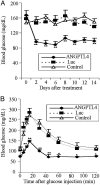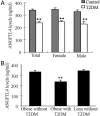Angiopoietin-like protein 4 decreases blood glucose and improves glucose tolerance but induces hyperlipidemia and hepatic steatosis in mice
- PMID: 15837923
- PMCID: PMC1087912
- DOI: 10.1073/pnas.0408452102
Angiopoietin-like protein 4 decreases blood glucose and improves glucose tolerance but induces hyperlipidemia and hepatic steatosis in mice
Abstract
Angiopoietin-like protein 4 (ANGPTL4) is a circulating protein predominantly expressed in adipose tissue and liver. Several recent studies demonstrated that ANGPTL4 is the target gene of peroxisome proliferation activators, the agonists of which are widely used as the antidiabetic and lipid-lowering drugs. Here we provide evidence that ANGPTL4 is a blood-borne hormone directly involved in regulating glucose homeostasis, lipid metabolism, and insulin sensitivity. Adenovirus-mediated expression of ANGPTL4 potently decreased blood glucose and improved glucose tolerance, whereas it induced hyperlipidemia, fatty liver, and hepatomegaly in C57 mice. In db/db diabetic mice, ANGPTL4 treatment reduced hyperglycemia to a normal level, and markedly alleviated glucose intolerance and hyperinsulinemia. Ex vivo studies on primary rat hepatocytes revealed that ANGPTL4 significantly decreased hepatic glucose production and enhanced insulin-mediated inhibition of gluconeogenesis. Serum levels of ANGPTL4 in human subjects inversely correlated with plasma glucose concentrations and HOMA IR, the homeostasis model assessment of insulin resistance. In patients with type 2 diabetes, serum levels of ANGPTL4 were significantly lower than those in healthy subjects, suggesting that the decreased ANGPTL4 could be a causative factor of this disease. These results collectively indicate that ANGPTL4 exerts distinct effects on glucose and lipid metabolism, and that its beneficial effect on glucose homeostasis might be useful for the treatment of diabetes.
Figures






References
-
- Kershaw, E. E. & Flier, J. S. (2004) J. Clin. Endocrinol. Metab. 89, 2548-2556. - PubMed
-
- Lyon, C. J., Law, R. E., Hsueh, W. A., Chaldakov, G. N., Stankulov, I. S., Hristova, M. & Ghenev, P. I. (2003) Endocrinology 144, 2195-2200. - PubMed
-
- Friedman, J. M. & Halaas, J. L. (1998) Nature 395, 763-770. - PubMed
-
- Matsuzawa, Y., Funahashi, T., Kihara, S. & Shimomura, I. (2004) Arterioscler. Thromb. Vasc. Biol. 24, 29-33. - PubMed
Publication types
MeSH terms
Substances
LinkOut - more resources
Full Text Sources
Other Literature Sources
Medical
Molecular Biology Databases
Miscellaneous

